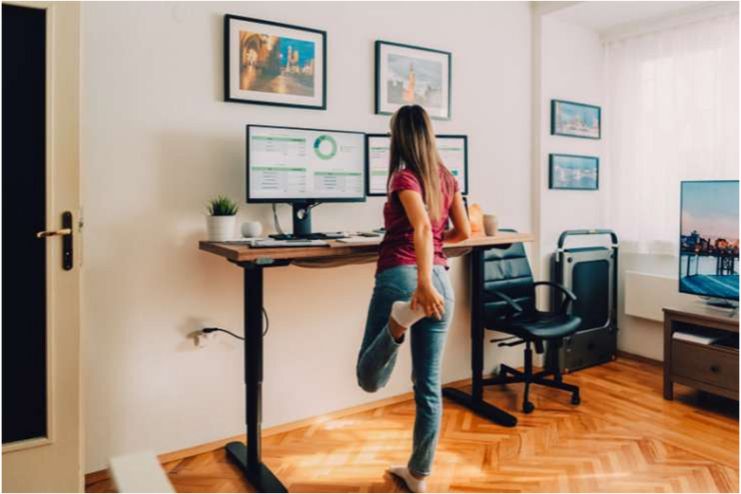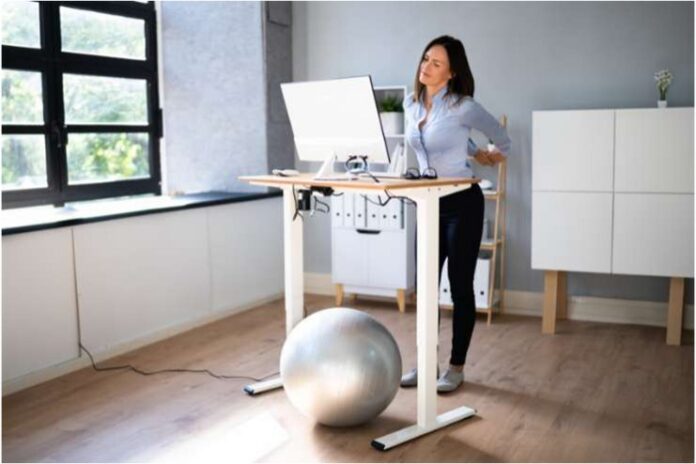Affiliate Disclaimer
Some links in this article are affiliate links. We may earn a small commission if you make a purchase through these links, at no extra cost to you. We only recommend products we find useful to our readersAre you a health-conscious office worker searching for ways to enhance your well-being while maintaining productivity in today’s fast-paced workplace?
The standing desk is a game-changer. It is an ergonomic substitute for conventional office arrangements. Standing desks enable users to switch between sitting and standing, which improves posture and movement throughout the day, in contrast to traditional workstations that lead to extended periods of sitting.
Standing desks have become incredibly popular to counteract the detrimental consequences of sedentary lifestyles. Both large corporations and remote workers are adding them to their workspaces. Driven by the goals of improved productivity, greater focus, and better health, they are rapidly becoming a trend in office settings.
In this article, we will discuss the benefits of standing desks that many people might not know about.
Read More: Can Standing Desks Reduce Your Risk of Chronic Back Pain?
What is a Standing Desk?
Instead of sitting in a chair, you can work at your “desk job” while standing, thanks to these innovative desks. They can be specially made (costing thousands of dollars), or you can elevate your computer to create a standing desk out of a standard desk for nothing. Not only does it help improve your health, but it also aids in preventing several deadly lifestyle diseases.
Instead of sitting on a chair for eight long hours, a standing desk allows you to work on your laptop while standing and encourages movement.
Benefits of a Standing Desk

According to recent research from groups like the American Heart Association, sitting for extended periods increases the chances of developing diabetes, heart disease, and other dangerous illnesses.
You can break up these extended periods of sitting by using a standing desk, even for a portion of the day. Alternating between standing and sitting can help reduce the risk of cardiac problems, reduce back pain, and increase vitality.
Professor Andrew Huberman of Stanford University is a master communicator. Neuroscientists and other academicians respect his research. He hosts the Huberman Lab podcast, which has over 3.5 million YouTube subscribers and routinely ranks in the top 10 podcasts on Spotify and Apple.
Andrew Huberman talks about sitting and standing while working in this clip from his podcast.
“People who decreased their sitting time by around half each day… showed incredible signs of reduced neck and shoulder pain, increases in subjective health and vitality in a work-related environment, and perhaps most importantly, improvements in their cognitive conditioning.”
Here are a few advantages to standing desks that are unquestionably worth mentioning:
1. Keeps Obesity At Bay
One of the most common ways sitting desk jobs affect our lives is because they lead to minor to no activity throughout the day. Sitting constantly prevents any form of calorie burning, raising the risk of obesity.
A standing desk helps by inverting the proportion of burned calories to ingested calories. If you consume more than what you are burning away, it will contribute to obesity.
Standing at the desk at work helps burn off around 170 calories, which is impressive.
2. Relieves Back Pain
Prolonged sitting can result in chronic back discomfort, stiff muscles, and bad posture. A standing desk can ease pain and reduce the strain on your back by allowing you to alternate between sitting and standing. Standing for short periods helps strengthen your back and core muscles, improving alignment and easing lower back strain.
Read More: 10 Best Balance Boards for Standing Desk – Improve your Posture
3. Manages Blood Sugar Levels
A sedentary lifestyle and lack of a proper diet are often two of the most common reasons behind diabetes.
A study of 10 subjects found that workers who stood and worked for 180 minutes following their lunch break had a 43% spike in their blood insulin level, which was definitely not witnessed otherwise.
Not only that, but even alternating standing and sitting for around 30 minutes was found to lower the risks of developing diabetes, especially type-2 diabetes, by around 11.1% on average.
4. Reduces Risk of Cardiovascular Diseases
Standing or moving around frequently instead of sitting all day improves circulation and heart function. Blood flow slows down when people sit for extended periods, which can raise their risk of cardiovascular disease.
The American Heart Association states that regular exercise can aid in controlling blood pressure, blood sugar, and cholesterol levels—all of which are important for heart health. By improving circulation and lowering the risk of heart disease, a standing desk can help you maintain long-term health.
5. Promotes Good Posture
Standing desks ease tension in the neck, shoulders, and back by promoting good spinal alignment, which improves posture. Standing instead of slouching on a chair reduces muscle stress by allowing you to maintain an erect head and relaxed shoulders.
Your body naturally aligns when your arms rest at a 90-degree angle, and your screen is at eye level, which lowers the chance of problems associated with bad posture. This better alignment can increase comfort and productivity by preventing chronic back pain, neck stiffness, and tension headaches.
Read More: 13 Benefits Of Good Posture – Sit Up Straight!
6. Increase Your Energy Levels
Standing improves blood flow and oxygen levels, boosting vitality and output. 87% of participants in a 7-week research, who used a standing workstation, reported feeling more energized all day.
Alternating between standing and sitting is a good way to prevent the all-too-usual mid-afternoon slump. Standing improves blood flow and increases alertness.
7. Increased Life Span
Our lifespan is predominantly dependent on how we spend our time today. If our health is not optimal, the same will affect our overall lifespan. Standing work desks benefit us by impacting our overall health and promoting an active lifestyle, a key factor in increased lifespan.
8. Lower the Chance of Some Cancers
Studies have linked long periods of sitting to an increased risk of developing some kinds of cancer, including endometrial, breast, and colon cancer. In addition to lowering this risk, using a standing desk can motivate you to move more frequently, like taking a walk around the workplace, for even more significant health benefits.
Read More: Best Yoga at Your Desk – 10 Convenient Office Yoga Poses
9. Boosts Your Mood
Researchers have associated increased standing with better mood and mental health in general. According to research, standing can increase serotonin and endorphins, two neurotransmitters linked to happiness, and a lower stress level. This all-natural mood enhancer lessens weariness and worry.
Many people who include standing in their daily routines say they feel more upbeat, renewed, and less stressed all day. Switching to a standing desk can significantly impact the situation, even as a minor adjustment.
How Long To Stand At Standing Desk?

Now that we have discussed the benefits of using a standing desk, it is time to discuss the time frame one needs to follow when working at one. It is essential to ensure that you take breaks between your standing so as not to aggravate some conditions.
Standing too much can cause back strain and leg pain, which are regular problems if you ignore your posture and don’t rest. The aim is to find a balanced sit-stand ratio that promotes comfort, productivity, and good circulation.
The precise ratio of standing to sitting is debatable, although many ergonomics experts advise switching between positions every 30 to 60 minutes. A 1:1 or 2:1 sitting-to-standing ratio is generally adequate for most individuals; for every 30 minutes spent sitting, you should stand for 30 minutes, or for every 40 minutes spent seated, you should stand for 20 minutes.
Start Slowly: If you’re currently entirely sedentary, start by standing for ten to fifteen minutes each hour. As your body adjusts, gradually increase the time you spend standing.
Pay Attention to Your Body: If your lower back or feet hurt, move to a sitting position. As your leg and core muscles strengthen, you can stand for extended periods.
Read More: 10 Best Posture Support Products for Work: Ergonomic Must-Haves
Conclusion
Moving from a regular desk to a standing desk promotes mobility, flexibility, and long-term health. Standing increases circulation, reduces back discomfort, improves posture, increases energy levels, and even supports heart health.
The advantages extend beyond physical health and support improved concentration, output, and a healthier work environment. But shifting doesn’t have to be a big deal; start small. With time, standing will become as comfortable as sitting, if not more so!
Are you prepared to switch, then? Are you considering getting a standing desk, or have you already tried one? We’d love to hear about your experience and suggestions for remaining active at work, so please share your ideas in the comment section below!
-
Nov 2018Written by Somapika D
-
Feb 2025Edited by Ankita
References
- https://thestandingdesk.com/standing-desks-101-everything-you-need-to-know
- https://www.webmd.com/fitness-exercise/standing-desks-help-beat-inactivity
- https://www.upliftdesk.com/benefits-of-a-standing-desk
- https://www.healthline.com/nutrition/7-benefits-of-a-standing-desk
- https://thestandingdesk.com/top-10-health-benefits-of-a-standing-desk
- https://www.heart.org/en/news/2023/05/23/sitting-too-much-may-raise-heart-disease-risk
- https://www.heart.org/en/health-topics/heart-attack/life-after-a-heart-attack/lifestyle-changes-for-heart-attack-prevention
- https://pubmed.ncbi.nlm.nih.gov/23057991
- https://www.healthline.com/nutrition/7-benefits-of-a-standing-desk#TOC_TITLE_HDR_9
- https://thestandingdesk.com/top-10-health-benefits-of-a-standing-desk
- https://thestandingdesk.com/how-long-should-you-stand-at-a-standing-desk
In this Article


















